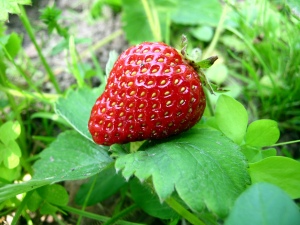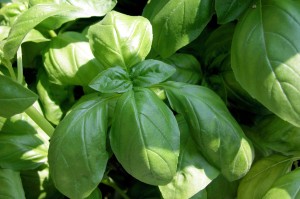The Buddha told this story:
A man travelling across a field encountered a tiger. He fled, the tiger after him. Coming to the precipice, he caught hold of the root of a wild vine and swung himself down over the edge. The tiger sniffed at him from above. Trembling, the man looked down to where, far below, another tiger was waiting to eat him. Only the vine sustained him.
Two mice, one white and one black, little by little started to gnaw away the vine. The man saw a luscious strawberry near him. Grasping the vine with one hand, he plucked the strawberry with the other. How sweet it tasted !
from 101 Zen Stories
Heightened sense of taste can promote weight loss
In a 2008 scientific experiment, lead by Alan Hirsch, MD. , director of the Smell & Taste Treatment and Research Foundation in Chicago, a group of people of an average weight of 208 pounds ate bland tasting food sprinkled with flavored crystals. The flavors used were cheddar cheese, onion, horseradish, ranch dressing, taco, or parmesan, cocoa, spearmint, banana, strawberry, raspberry, and malt. People in this study were not submitted to a diet and lost an average of 30 pounds in 6 months, compared to 2 pounds for the control group.
Hirsch theorized that subjects lost weight because the added flavors made them feel full faster and they therefore eat less. He said he believes this approach works because, unlike most diets, it is not based on food restriction.
Some of the subjects even stopped the study before 6 months because they already had reached their ideal body weight–an unexpected result, Hirsh said.
Weight loss Using taste and smell sensations
In another 2009 a study published in the Journal of Women’s Health, a study by John M. Poothullil, M.D., showed that participants lost weight by becoming aware of taste and smell sensations. Seven women learned to stop eating when they became aware that the food was no longer pleasant to eat. By the end of 1 month, significant weight loss took place in the study group, and was maintained throughout the study period of 1 year.
Better tasting food requires a lesser quantity
Ayurvedic medicine –an ancient Hindu system of medicine- recognizes six types of taste.
- sweet
- sour
- salty
- hot
- bitter
- astringent
The six tastes should be balanced in the diet for optimum health and nutrition. (from http://www.mapi.com/ayurveda_health_care/newsletters/newsfood-bitter.html)
Without necessarily choosing to follow an ayurvedic diet –it would be another topic – it is great to keep these six tastes in mind. Then, you can see what kind of taste you are missing in your diet..
Examples of sweet, salty, hot and sour taste are easy to find. The following are examples of foods and spices for the bitter and astringent tastes:
Bitter Taste:
- bitter melon and gourd
- Japanese eggplant
- turmeric
- fenugreek seeds
- leafy greens
- barley
- basil
- nettle
- jicama
- lettuce
- aloe vera
Astringent Taste:
- apple
- pomegranate (tastes sour on the tongue but is both astringent and bitter)
- pear
- quinoa
- legumes
- tofu
- sprouts
- beans
- lentils
Bitter food for health and pleasure
Dr. Adam Drewnowski, Director of the University of Washington Nutritional Sciences Program, is one of the main advocates of bitter foods: spinach, brussels sprouts, cabbage, kale, mustard greens, radicchio, and dark chocolate prevent many diseases including cancer, because they contain phytonutrients. Unfortunately the food industry has removed and masked the bitter taste that has become undesirable. We are treated like spoiled children who only want to eat sweets, and very salty food.
Chocolate is one of these foods that is pleasantly bitter. If you eat a very sweet chocolate -35% cocoa- you cannot appreciate fully the taste of cocoa. You need a bar to taste the flavor. If you eat the best bitter chocolate -85% cocoa- you only need a square to fill your mouth with flavor for a long time. Don’t take my word for it, try it.
A very tasty nutrient-rich shopping list
Dr. Adam Drewnowski, is at the origin of the Nutrient Rich Foods coalition. Among other useful information the website has a ready-made grocery shopping list with examples of nutrient-rich foods. It helps remind you to enjoy a wide variety of nutrient-rich foods and beverages (http://www.nutrientrichfoods.org/wp-content/uploads/nutrient-rich-shopping-list.pdf)
Try discovering new flavors this week and enjoy a week filled with many tastes…







